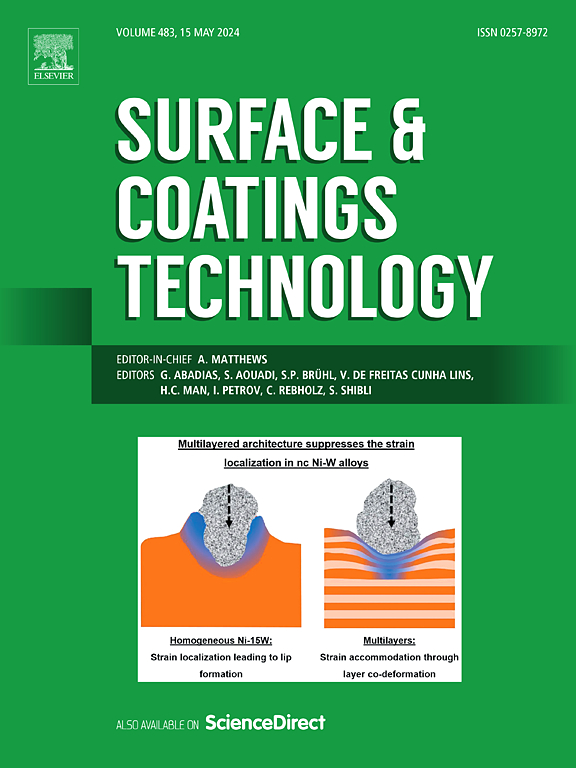Effect of transition metals (Nb, Ta, and V) doping on the high-temperature mechanical and tribological properties of CrYN coatings
IF 6.1
2区 材料科学
Q1 MATERIALS SCIENCE, COATINGS & FILMS
引用次数: 0
Abstract
This study focused on developing a high-temperature tribological coating for AISI 316L stainless steel. CrYN coatings doped with transition metals such as niobium, tantalum, and vanadium (Me-CrYN) were deposited using a closed-field unbalanced magnetron sputtering (CFUBMS) system. In a previous study, the Taguchi L9 orthogonal array design was employed to optimize the deposition parameters based on tribological performance under dry sliding conditions at room temperature. Among the nine experimental runs, the three coatings exhibiting the lowest friction coefficients and highest wear resistance were selected for high-temperature tribological testing. In the present work, these three optimized Me-CrYN coatings were systematically evaluated for their tribological and adhesion properties at elevated temperatures. High-temperature tribological performance was assessed using a pin-on-disc tribometer in ambient air at 450 °C, 550 °C, and 650 °C, with particular attention given to their frictional behavior. Additionally, adhesion strength was evaluated at room temperature via scratch testing, both on the as-deposited coatings and those subjected to high-temperature tribological testing at 450 °C, 550 °C, and 650 °C. The results demonstrate that the Me-CrYN coatings maintain tribomechanical stability at elevated temperatures, with hardness values ranging from 8.8 to 15.3 GPa. Nb-doped coatings exhibited a reduction in friction from ∼0.55 at room temperature to ∼0.30 at 650 °C (≈45 % decrease), while Ta-doped coatings maintained stable values around 0.40 across all temperatures (<5 % variation). In contrast, V-doped coatings showed an initial rise from ∼0.13 at room temperature to ∼0.30 at 450 °C (≈115 % increase), but then decreased to ∼0.10 at 550 °C (≈25 % below RT) and ∼0.12 at 650 °C (≈10 % below RT). Adhesion strength was preserved after thermal exposure, supporting their potential for high-temperature applications.
过渡金属(Nb、Ta和V)掺杂对CrYN涂层高温力学和摩擦学性能的影响
本研究的重点是研制aisi316l不锈钢的高温摩擦涂层。采用闭场不平衡磁控溅射(CFUBMS)系统制备了掺杂过渡金属铌、钽和钒(Me-CrYN)的CrYN涂层。在之前的研究中,基于室温干滑动条件下的摩擦学性能,采用Taguchi L9正交阵列设计优化沉积参数。在9次试验中,选择摩擦系数最低、耐磨性最高的3种涂层进行高温摩擦学测试。在本工作中,系统地评估了这三种优化的Me-CrYN涂层在高温下的摩擦学和粘附性能。在450°C、550°C和650°C的环境空气中,使用针盘式摩擦计评估了高温摩擦学性能,并特别关注了它们的摩擦行为。此外,在室温下通过划痕测试来评估粘附强度,包括沉积涂层和在450°C、550°C和650°C下进行的高温摩擦学测试。结果表明,Me-CrYN涂层在高温下保持摩擦力学稳定性,硬度值在8.8 ~ 15.3 GPa之间。nb掺杂涂层的摩擦系数从室温下的0.55降低到650℃时的0.30(降低约45%),而ta掺杂涂层在所有温度下都保持在0.40左右的稳定值(变化幅度为<; 5%)。相比之下,v掺杂涂层在室温下从0.13上升到450°C时的0.30(增加约115%),但在550°C时下降到0.10(低于RT≈25%),在650°C时下降到0.12(低于RT≈10%)。热暴露后的粘附强度保持不变,支持其高温应用的潜力。
本文章由计算机程序翻译,如有差异,请以英文原文为准。
求助全文
约1分钟内获得全文
求助全文
来源期刊

Surface & Coatings Technology
工程技术-材料科学:膜
CiteScore
10.00
自引率
11.10%
发文量
921
审稿时长
19 days
期刊介绍:
Surface and Coatings Technology is an international archival journal publishing scientific papers on significant developments in surface and interface engineering to modify and improve the surface properties of materials for protection in demanding contact conditions or aggressive environments, or for enhanced functional performance. Contributions range from original scientific articles concerned with fundamental and applied aspects of research or direct applications of metallic, inorganic, organic and composite coatings, to invited reviews of current technology in specific areas. Papers submitted to this journal are expected to be in line with the following aspects in processes, and properties/performance:
A. Processes: Physical and chemical vapour deposition techniques, thermal and plasma spraying, surface modification by directed energy techniques such as ion, electron and laser beams, thermo-chemical treatment, wet chemical and electrochemical processes such as plating, sol-gel coating, anodization, plasma electrolytic oxidation, etc., but excluding painting.
B. Properties/performance: friction performance, wear resistance (e.g., abrasion, erosion, fretting, etc), corrosion and oxidation resistance, thermal protection, diffusion resistance, hydrophilicity/hydrophobicity, and properties relevant to smart materials behaviour and enhanced multifunctional performance for environmental, energy and medical applications, but excluding device aspects.
 求助内容:
求助内容: 应助结果提醒方式:
应助结果提醒方式:


